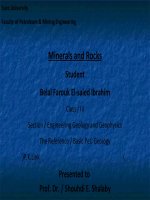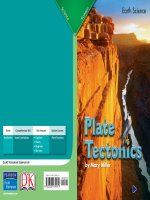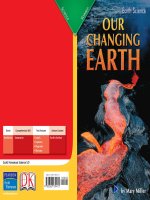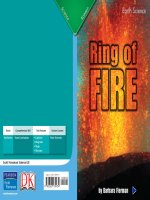earth science minerals and rocks
Bạn đang xem bản rút gọn của tài liệu. Xem và tải ngay bản đầy đủ của tài liệu tại đây (5.95 MB, 10 trang )
by Audrey N. Delmar
Scott Foresman Science 4.8
Genre Comprehension Skill Text Features Science Content
Nonfi ction Summarize • Labels
• Captions
• Charts
• Glossary
Rocks and
Minerals
ISBN 0-328-13880-0
ì<(sk$m)=bdiiah< +^-Ä-U-Ä-U
Earth Science
13880_CVR_FSD Cover113880_CVR_FSD Cover1 5/26/05 12:40:27 PM5/26/05 12:40:27 PM
by Audrey N. Delmar
Scott Foresman Science 4.8
Genre Comprehension Skill Text Features Science Content
Nonfi ction Summarize • Labels
• Captions
• Charts
• Glossary
Rocks and
Minerals
ISBN 0-328-13880-0
ì<(sk$m)=bdiiah< +^-Ä-U-Ä-U
Earth Science
13880_CVR_FSD Cover113880_CVR_FSD Cover1 5/26/05 12:40:27 PM5/26/05 12:40:27 PM
Illustration: 6, 9, 11, 15 Alan Male
Photographs: Every effort has been made to secure permission and provide appropriate credit for
photographic material. The publisher deeply regrets any omission and pledges to correct errors called to its
attention in subsequent editions. Unless otherwise acknowledged, all photographs are the property of Scott
Foresman, a division of Pearson Education. Photo locators denoted as follows: Top (T), Center (C), Bottom
(B), Left (L), Right (R) Background (Bkgd)
Opener: (Bkgd) ©Ted Mead/PhotoLibrary, (TC) ©DK Images; Title Page: (CC) ©DK Images; 2 (L, C,
CR, BR) ©DK Images, (BR) GeoScience Resources/American Geological Institute; 3 (BR) ©Colin Keates/
Courtesy of the Natural History Museum, London/©DK Images; (T, CL, C) ©DK Images; 4 (1–8,10) ©DK
Images, (9) Colin Keates/Courtesy of the Natural History Museum, London/©DK Images; 5 (T, BL) ©DK
Images, (CL) Natural History Museum/©DK Images, (C) Colin Keates/Courtesy of the Natural History
Museum, London/©DK Images; 7 ©DK Images; 8 (TL, TR) ©DK Images, (CL) Dave King/©DK Images,
(BR) ©Danny Lehman/Corbis; 10 (BL) Harry Taylor/Courtesy of the Natural History Museum, London/
©DK Images, (BR) Colin Keates/Courtesy of the Natural History Museum, London/©DK Images; 12 (TL,
TR, BR) ©DK Images, (BL) Colin Keates/Courtesy of the Natural History Museum, London/©DK Images; 13
Alan Williams/©DK Images; 14 (BL) ©DK Images, (B) Richard M. Busch; 15 ©DK Images.
ISBN: 0-328-13880-0
Copyright © Pearson Education, Inc.
All Rights Reserved. Printed in the United States of America. This publication is
protected by Copyright and permission should be obtained from the publisher prior
to any prohibited reproduction, storage in a retrieval system, or transmission in any
form by any means, electronic, mechanical, photocopying, recording, or likewise. For
information regarding permissions, write to: Permissions Department, Scott Foresman,
1900 East Lake Avenue, Glenview, Illinois 60025.
3 4 5 6 7 8 9 10 V010 13 12 11 10 09 08 07 06 05
Vocabulary
igneous rock
luster
metamorphic rock
mineral
sediment
sedimentary rock
What did you learn?
1. What are some physical properties of minerals that
scientists test?
2. What are the three kinds of rock?
3. What are some forces that cause the changes that take
place in the rock cycle?
4.
Over time, rock changes to
soil. On your own paper, describe how this happens.
Use details from the book to support your answer.
5.
Summarize Explain the steps that take place in
order for a fossil to form.
13880_CVR_FSD Sec1:213880_CVR_FSD Sec1:2 5/26/05 12:40:38 PM5/26/05 12:40:38 PM
Minerals and Rocks
by Audrey N. Delmar
13880_01-16_FSD.indd 113880_01-16_FSD.indd 1 5/26/05 12:42:27 PM5/26/05 12:42:27 PM
2
What are minerals?
Mineral Crystals
A mineral is a natural, nonliving solid crystal that makes
up rocks. The salt you put on your food is a mineral. A metal
fork is made of minerals.
Every mineral has crystals. Fluorite crystals are cube-shaped.
Corundum crystals are six-sided. A mineral has the same shape
crystals and the same chemicals in it no matter where it is
found. A piece of quartz in Australia has the same chemical
makeup as a piece of quartz in Arkansas.
Granite contains quartz,
mica, and feldspar crystals.
Quartz is
hard and
glassy.
Mica can form rocks that
are brown or black.
Feldspar is
often white
or pink.
13880_01-16_FSD.indd 213880_01-16_FSD.indd 2 5/26/05 12:42:29 PM5/26/05 12:42:29 PM
3
Scientists have found more than 3,000 minerals. But only
a small number of them make up most of the rocks in Earth’s
crust. These are “rock-forming” minerals. Most rocks are a
combination of these minerals. Granite is made of quartz,
mica, and feldspar crystals. White marble has only the mineral
calcite.
Cinnabar
Orpiment
Pyrite
13880_01-16_FSD.indd 313880_01-16_FSD.indd 3 5/26/05 12:42:32 PM5/26/05 12:42:32 PM
4
How to Identify a Mineral
Scientists test different properties
in order to identify minerals. Some
properties they test are color, luster,
hardness, streak, and cleavage.
A mineral’s color is easy to see.
Feldspar minerals are usually pink or
white. But some minerals can be several
different colors. Scientists must use other
tests such as luster. The luster of a
mineral is how its surface reflects light.
Luster can be dull, metallic, pearly, glassy,
greasy, or silky.
Hardness
The Mohs Scale for Hardness tells
scientists how easily a mineral can be
scratched. The scale is from 1 to 10.
A mineral with a higher number can
scratch minerals with lower numbers.
Topaz is an 8. Quartz is a 7. Topaz is
harder than quartz. It will scratch quartz.
Mohs Scale
for Hardness
9 Corundum
8 Topaz
7 Quartz
6 Feldspar
5 Apatite
4 Fluorite
3 Calcite
2 Gypsum
1 Talc
10 Diamond
13880_01-16_FSD.indd 413880_01-16_FSD.indd 4 5/26/05 12:42:34 PM5/26/05 12:42:34 PM
5
Streak
Streak is measured using a special plate. A mineral is scratched
on this plate. The color of the powder that it leaves is its streak.
No matter what color a mineral is, its streak is always the same
color. The mineral halite can be colorless to white, with pieces of
yellow, red, or blue. Halite’s streak is always white.
Color
Usually
colorless
or white
Dark green
Gold
Milky
Luster
Glassy
Glassy
Metallic
Glassy
Streak
White
Pale gray
Green-black
White
Mohs
Scale
2
5–6
6–6.5
7
Mineral
Calcite
Hornblende
Pyrite
Quartz
13880_01-16_FSD.indd 513880_01-16_FSD.indd 5 5/26/05 12:42:36 PM5/26/05 12:42:36 PM
How are sedimentary
rocks formed?
Layers of Rock
Erosion is the movement of material such as rock, soil,
shells, and dead plant and animal matter from one place to
another. The material is moved by wind, ice, water, and gravity.
It settles at the bottom of lakes, rivers, and oceans. It is called
sediment.
Sediment is carried into bodies of water. Particles of sediment
have different sizes and shapes. Some particles are smooth.
Others are sharp. New layers build on old layers, pressing
the older layers together. The weight of the layers
bonds the particles together. They harden and
form sedimentary rock.
6
13880_01-16_FSD.indd 613880_01-16_FSD.indd 6 5/26/05 12:42:41 PM5/26/05 12:42:41 PM
Types of Sedimentary Rock
One kind of sedimentary rock comes from sediment
of material that was once alive. Limestone is made of
skeletons and shells of sea animals that lived long ago. Their
remains formed layers. These layers are held together by
dissolved minerals.
What kind of sediment do you think
makes up a sedimentary rock named
sandstone? Sandstone comes from
pieces of quartz that are about the
size of a grain of sand.
Mudstone is a third kind of
sedimentary rock. It forms in lakes
or oceans from tiny pieces of clay
minerals. Mudstone is similar to a
sedimentary rock named shale.
7
Conglomerate forms from
round pieces of rock that
are stuck together.
13880_01-16_FSD.indd 713880_01-16_FSD.indd 7 5/26/05 12:42:55 PM5/26/05 12:42:55 PM
8
How Rocks Change into Soil
Water can drip into cracks in rock. The water freezes and
thaws again and again. As the cracks get bigger, the rock
gets weaker. Eventually the pieces of rock break. Plant roots
can force themselves into a rock. This also can cause the
rock to break into pieces. These natural processes are known
as weathering. Weathering can wear away even the tallest
mountain over millions of years.
Soil is made of tiny pieces of weathered rock. Soil also has
dead and decaying plant and animal matter. Soil even has
living things such as bacteria, fungi, worms, and insects. They
break up the plant and animal material into nutrients for
plants to use.
Weathering wears away
these rock formations.
13880_01-16_FSD.indd 813880_01-16_FSD.indd 8 5/26/05 12:43:05 PM5/26/05 12:43:05 PM
9
How Rocks Tell a Story
Sedimentary rocks can tell scientists about life on Earth
millions of years ago. Scientists may find a 100-million-year-old
dinosaur footprint. They may find a copy of a set of teeth
from an animal that became extinct, or died out, 50 million
years ago.
The footprints and teeth are fossils. Fossils give scientists
clues about life on Earth long ago. Many fossils are found in
sedimentary rocks.
Scientists get information from fossils. Fossils might tell
how many legs a dinosaur walked on. They might tell what
plants and animals looked like. They can even tell how Earth’s
features and environment have changed.
The soft body parts of an animal
decay after the animal dies.
Many layers form. Eventually
the remains are replaced with
minerals that harden into rock.
Sediment settles on top of the
remains.
The rock layers weather.
The fossil appears at the surface.
1. 2.
3. 4.
13880_01-16_FSD.indd 913880_01-16_FSD.indd 9 5/26/05 12:43:29 PM5/26/05 12:43:29 PM
10
How a Fossil Forms
Scientists can form ideas about Earth’s history from fossils.
They can tell when certain plants and animals lived. To do this,
they figure out the age of the layer of rock in which the plant or
animal was found. For example, ammonoids were sea creatures
that looked like snails. Scientists think ammonoids lived from
about 408 to 66 million years ago. An ammonoid fossil means
that the layer of rock formed between 408 and 66 million years
ago. Different layers of rock tell scientists how living things
have changed.
Geologic Time Scale
Scientists have used their estimates of Earth’s history to
make a geologic time scale. The earliest period of time is at
the bottom of the scale. The scale is in the same order as the
layers of sedimentary rock. The layers with the oldest fossils are
at the bottom. The newest layers are on top. The four major
time periods are the Precambrian era, the Paleozoic era, the
Mesozoic era, and the Cenozoic era.
Scientists use what they learn
from fossils to make models
of extinct animals.
13880_01-16_FSD.indd 1013880_01-16_FSD.indd 10 5/26/05 12:43:33 PM5/26/05 12:43:33 PM
11
Present
65 million years ago —Cenozoic era
248 million years ago —Mesozoic era
544 million years ago—Paleozoic era
over 544 million years ago—
Precambrian era
13880_01-16_FSD.indd 1113880_01-16_FSD.indd 11 5/26/05 12:43:35 PM5/26/05 12:43:35 PM
12
What are igneous and
metamorphic rocks?
Igneous Rocks
Some rocks can melt. The layer of rock below Earth’s crust is
so hot that it is partly melted. This molten, or melted, rock is
magma. Igneous rock is molten rock that has hardened.
Igneous rock forms above or below Earth’s surface.
Sometimes magma bursts out of a volcano in hot, gooey
clumps. Magma is called lava when it reaches the surface. Lava
may flow from a volcano as a hot river. Lava on Earth’s surface
cools quickly. It may harden into igneous rock in just a few
days. Igneous rock that cools very quickly does not form many
crystals.
Magma usually rises slowly to Earth’s surface. It fills in cracks
in the crust. As it slowly cools into rock, large crystals form. This
slow cooling can take more than a million years!
Basalt is the most
common quickly
cooled igneous rock.
Most of the ocean
floor is basalt.
Gabbro cools
slowly. The
minerals in it
may separate
into layers.
13880_01-16_FSD.indd 1213880_01-16_FSD.indd 12 5/26/05 12:43:46 PM5/26/05 12:43:46 PM
13
The Giant’s Causeway
A causeway is a road built above water. It is built on pillars.
These basalt pillars are called the Giant’s Causeway. The tops of
these pillars are stepping stones that lead to the sea. There are
about 40,000 of these columns. They are located in Northern
Ireland. The pillars formed between 50 and 60 million years
ago. Lava cooled quickly when it reached the sea. It squeezed
together. Cracks from the top to the bottom of the rock formed
these pillars. Many of the pillars have six sides.
13880_01-16_FSD.indd 1313880_01-16_FSD.indd 13 5/26/05 12:43:48 PM5/26/05 12:43:48 PM
14
Metamorphic Rocks
Rock is under pressure below the surface of Earth. It is
squeezed by the weight of other rocks. This can cause rocks to
change form. Rock that has changed as a result of heat and
pressure is called metamorphic rock.
Metamorphic rock can form from sedimentary, igneous,
or other metamorphic rock. Limestone is sedimentary rock. It
can become the metamorphic rock marble. Rock can change
form more than once.
Rock can change in many ways as it becomes
metamorphic rock. Heat and pressure can cause the rock’s
mineral crystals to change. They may form again with new
crystals of different sizes and shapes. The heat and pressure
can also cause minerals to form parallel layers. This means
some metamorphic rock may chip into flat sheets and slabs.
Gneiss forms from
sedimentary or
igneous rock.
Phyllite forms from
sedimentary rock. Its
minerals are layered.
13880_01-16_FSD.indd 1413880_01-16_FSD.indd 14 5/26/05 12:43:53 PM5/26/05 12:43:53 PM
15
The metamorphic
rock slate
forms from the
sedimentary rock
shale.
The Rock Cycle
The rock cycle is the recycling of old rock into new. It is an
ongoing process. The rock cycle needs forces such as heat,
pressure, chemical reactions, weathering, and erosion. All
three kinds of rock can change from one form to another. Not
all rock completes the entire cycle. Rock deep in the crust may
never reach the surface. It may never change. Sedimentary
rock can melt and harden into igneous rock.
Slate is a metamorphic rock. It forms from shale, a
sedimentary rock. Slate and shale can wear away to form
new layers of sediment. These layers can harden into
sedimentary rock. Rock under Earth’s surface can melt and
then form igneous rock. Over time the same materials can
change into different types of rock.
13880_01-16_FSD.indd 1513880_01-16_FSD.indd 15 5/26/05 12:43:54 PM5/26/05 12:43:54 PM
16
Glossary
igneous rock rock that forms from cooled
molten rock
luster a measure of the way the surface of a
mineral reflects light
metamorphic rock rock that has changed as a result of
heat and pressure
mineral a natural, nonliving solid crystal that
makes up rocks
sediment the eroded material that settles at the
bottom of lakes, rivers, and oceans
sedimentary rock rock that forms when layers of
sediment particles harden
13880_01-16_FSD.indd 1613880_01-16_FSD.indd 16 5/26/05 12:43:54 PM5/26/05 12:43:54 PM
Illustration: 6, 9, 11, 15 Alan Male
Photographs: Every effort has been made to secure permission and provide appropriate credit for
photographic material. The publisher deeply regrets any omission and pledges to correct errors called to its
attention in subsequent editions. Unless otherwise acknowledged, all photographs are the property of Scott
Foresman, a division of Pearson Education. Photo locators denoted as follows: Top (T), Center (C), Bottom
(B), Left (L), Right (R) Background (Bkgd)
Opener: (Bkgd) ©Ted Mead/PhotoLibrary, (TC) ©DK Images; Title Page: (CC) ©DK Images; 2 (L, C,
CR, BR) ©DK Images, (BR) GeoScience Resources/American Geological Institute; 3 (BR) ©Colin Keates/
Courtesy of the Natural History Museum, London/©DK Images; (T, CL, C) ©DK Images; 4 (1–8,10) ©DK
Images, (9) Colin Keates/Courtesy of the Natural History Museum, London/©DK Images; 5 (T, BL) ©DK
Images, (CL) Natural History Museum/©DK Images, (C) Colin Keates/Courtesy of the Natural History
Museum, London/©DK Images; 7 ©DK Images; 8 (TL, TR) ©DK Images, (CL) Dave King/©DK Images,
(BR) ©Danny Lehman/Corbis; 10 (BL) Harry Taylor/Courtesy of the Natural History Museum, London/
©DK Images, (BR) Colin Keates/Courtesy of the Natural History Museum, London/©DK Images; 12 (TL,
TR, BR) ©DK Images, (BL) Colin Keates/Courtesy of the Natural History Museum, London/©DK Images; 13
Alan Williams/©DK Images; 14 (BL) ©DK Images, (B) Richard M. Busch; 15 ©DK Images.
ISBN: 0-328-13880-0
Copyright © Pearson Education, Inc.
All Rights Reserved. Printed in the United States of America. This publication is
protected by Copyright and permission should be obtained from the publisher prior
to any prohibited reproduction, storage in a retrieval system, or transmission in any
form by any means, electronic, mechanical, photocopying, recording, or likewise. For
information regarding permissions, write to: Permissions Department, Scott Foresman,
1900 East Lake Avenue, Glenview, Illinois 60025.
3 4 5 6 7 8 9 10 V010 13 12 11 10 09 08 07 06 05
Vocabulary
igneous rock
luster
metamorphic rock
mineral
sediment
sedimentary rock
What did you learn?
1. What are some physical properties of minerals that
scientists test?
2. What are the three kinds of rock?
3. What are some forces that cause the changes that take
place in the rock cycle?
4.
Over time, rock changes to
soil. On your own paper, describe how this happens.
Use details from the book to support your answer.
5.
Summarize Explain the steps that take place in
order for a fossil to form.
13880_CVR_FSD Sec1:213880_CVR_FSD Sec1:2 5/26/05 12:40:38 PM5/26/05 12:40:38 PM









